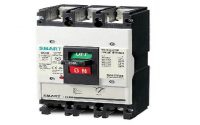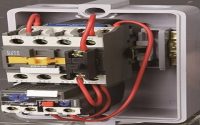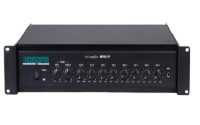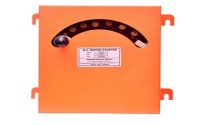What is Non-Polarized Capacitor : Working & Its Applications
As we know that a capacitor is a two-terminal passive component that is used in various electrical and electronic circuits. The main function of a capacitor is to store electrical energy. There are different types of capacitors available in different sizes and shapes which are used based on the requirement. A capacitor is constructed with two conductors where these two conductors are separated through the dielectric material. The classification of capacitors can be done based on different parameters like materials, size, polarity, shape, function, etc. But the capacitors based on polarity can be classified into two types polarized and non-polarized capacitors. So this article discusses one of the types of polarity-based capacitors like a non-polarized capacitor – working and its applications.
What is a Non-Polarized Capacitor?
Non-polarized capacitor definition is a type of capacitor that is not polarized which means this capacitor has neither positive polarity nor negative polarity. So it can be connected in any direction within a circuit. These capacitors can replace polarized capacitors completely until it meets some specifications like the working, capacity, volume, voltage, etc. The non-polarized capacitor symbol is shown below.
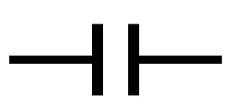
Types of Non-Polarized Capacitor
Non-polar capacitors are classified into different types which are discussed below.
Ceramic Capacitors
Ceramic capacitors are the most commonly used non-polarized type of capacitor. The old type of capacitors is disk-shaped capacitors whereas currently used capacitors are block-shaped. These capacitors are used for low-loss devices & high stability performances. The capacitance values of these devices are constant with respect to the applied frequency, voltage & temperature. They provide very precise results.
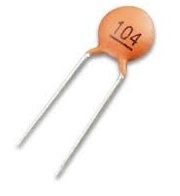
They perform very well within RF circuits and are accessible within the range of 10 pF to 1 microfarad range. Ceramic capacitors have some outflow across the dielectric so their temperature stability & performance will be changed based on the manufacturer.
Silver Mica Capacitors
The silver mica capacitor is designed with mica sheets including metal being covered on both sides. Its capacitance can be increased by adding several layers together and then dipped within an insulator Epoxy for safety against environmental effects.
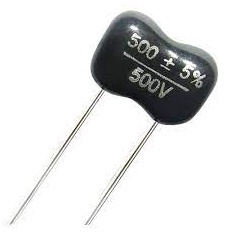
Silver mica capacitors are rarely used because they are fairly expensive but they are temperature tolerant & stable. They operate in the range of 1pF to 3000pF but they have little leakage across the dielectric. These capacitors are applicable where stability is necessary and used in filter and oscillator circuits.
As compared to ceramic capacitors, these are expensive. The voltage rating of these capacitors ranges from 100 v – 10 Kv and their capacitance ranges from 47 pF – 3000 pF. These capacitors are applicable in current electronic circuits due to their power handling & high voltage capabilities like amplifiers, resonance circuits, high voltage inverters, RF broadcast transmitters, etc.
Polyester Capacitors
Polyester capacitors are also called Mylar capacitors. The dielectric material is made of PET or polyethylene terephthalate which is a thermoplastic polar polymer. The structure of these capacitors can be made with Film or Foil structure & metalized film.
These capacitors are not expensive, have small leakage & accurate. The operating range of these capacitors ranges from 0.001 uF to 50 uF. These are applicable where stability and accuracy are not so significant.
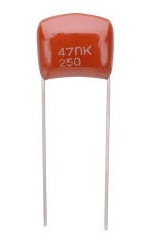
This capacitor can be used with no coating because they have the ability to restrict moisture. These capacitors’ dielectric strength & high permeability offers high volume efficiency. But its temperature coefficient of capacitance is high as compared to film capacitors. The temperature range of a polyester capacitor is up to 125° C. Its maximum operating voltage is about 60 Kv and its tolerance ranges from 5% to 10%.
Polystyrene Capacitors
Polystyrene capacitors are film capacitors that have little leakage & very accurate. So these are applicable where accuracy and stability are essential and also used in filters. These capacitors are designed in a tubular shape and they can be replaced by polyester film capacitors.
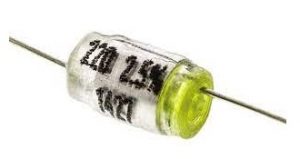
The operating range of these capacitors ranges from 10 pF to 1 uF. These capacitors offer nearly zero change within their capacitance once operating within their temperature range of about 85° C. These are used in general purpose applications which have less frequency and temperature.
Polycarbonate Capacitors
Polycarbonate capacitors have very high quality, high accuracy, are expensive, and have very less leakage across a dielectric. These capacitors work well in high temperatures & harsh and environments within the range of 100 pF to 20 uF range.
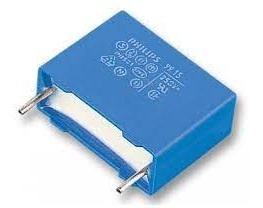
The dielectric material used in this resistor is polycarbonate and it is manufactured in both film and metalized structures. These capacitors offer very less loss & very high stability.
The operating temperature of this capacitor ranges from -55° to +125° C. The Polycarbonate film in this capacitor simply provides high tolerance to increase its reliability. These capacitors are used where temperature stability & low loss are required for timing & filtering circuits within a harsh environment.
Polypropylene Capacitors
The capacitor which uses a non-polar organic polymer material like Polypropylene as a dielectric is known as polypropylene capacitors. These capacitors are available in two configurations like film or foil and metalized which range from 100 pF to 50 uF. These capacitors are very accurate and stable with less leakage.
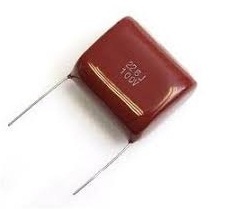
Polypropylene capacitors are more resistant to moisture as compared to polyester film capacitors, so they don’t require any safety coating also these capacitors are less dependent on frequency and temperature but their operating frequency is 100 KHz & maximum operating temperature is around 105° C. The maximum voltage rating of polypropylene capacitors is 400 Kv.
Polypropylene capacitors are applicable in low power applications like VCO & sample & hold circuits, high power induction heating, etc. These capacitors can also be used as power factor correction & AC motor run capacitors.
Teflon Capacitors
Teflon Capacitors uses a synthetic PTFE (polymer Polytetrafluoroethylene) as the dielectric material. These capacitors are available in both metalized and Foil or Film types. These capacitors are accurate, stable, and have less leakage almost, so they are widely used in different applications. These capacitors operate in the range of 100pF to 1 uF.
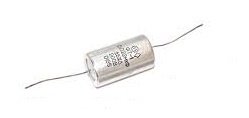
These capacitors are expensive and fairly bulky but they are extremely resistant to 200° C of a temperature with extremely fewer losses. Teflon capacitors are applicable in high-quality applications like military and aerospace equipment.
Glass Capacitors
Glass capacitors are very hard and used in very harsh environments. These capacitors are stable & operate in the range of 10pF to 1,000 pF but they are very expensive. These capacitors are applicable where the ultimate performance is required for RF circuits.
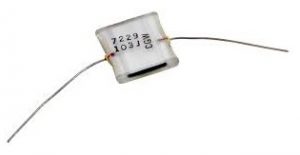
Glass dielectric capacitors provide an extremely high range of performance but they will have a fairly less capacitance value. The capacitors’ values may range from a pF to 1000pF. These capacitors are applicable in RF circuit design. The performance of these capacitors is very high.
How Does a Non-Polarized Capacitor Work?
The non-polarized capacitors are used in pure AC circuits and also in high-frequency filtering due to their small capacitance. The application circuit of the nonpolarized capacitor is the RC spark suppression circuit which is shown below.
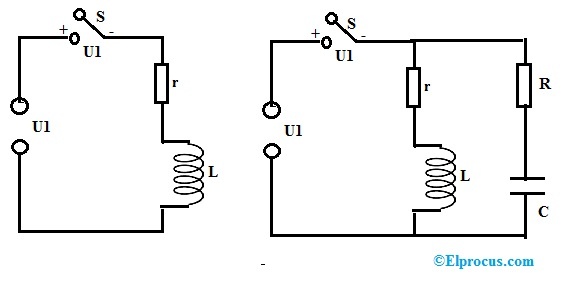
Once the radio & TV program is obtained from the antenna and the fluorescent lamp is turned on at the same time then you will listen to the irregular radio sound otherwise the TV speaker sound.
Generally, many bright spots and lines on the TV screen occur through electric sparks. Once circuits including inductance are detached, then a spark will be produced in between the two contacts shown in the above figure. Let us discuss on how a spark appears in a TV and how it can be rectified.
The switch-like ‘S’ is turned off then the flow of current will be disappeared quickly. As a result, a large self-inductance can be generated at both the coil ends. This electromotive force may delay the flow of current to change & its direction is steady with the voltage applied. When the two contacts are superimposed, then the ‘U1’ voltage across the switch ‘S1’ will be maximum.
Once the voltage is higher to a certain value, then the sharp voltage will go down the air to form an electric spark. The generated spark between two contacts may be oxidized & finally cause malfunction. So, it is significant to remove the spark in between two contacts.
When the flow of the current in the control coil does not fall, then the voltage at the two coil ends will not be very large, thus there will be no spark. In the above RC spark suppression circuit is simply connected at both the inductor ends. Once the switch ‘S’ is turned off suddenly, they will charge the capacitor ‘C’.
The magnetic field energy portion within the inductor ‘L’ can be dissolved on R & r and a portion can be changed into electric field energy within the capacitor, which causes the capacitor to discharge again thus the spark can be eliminated.
Non-Polarized Capacitor Vs Polarized Capacitor
The differences between a non-polarized capacitor and a polarized capacitor include the following.
|
Non-Polarized Capacitor |
Polarized Capacitor |
| The capacitor which has no implicit polarity is known as a non-polarized capacitor. | The capacitor which has an inherent polarity is known as a non-polarized capacitor. |
| This capacitor is also known as a non-polar capacitor. | This capacitor is also known as a polar capacitor. |
| The connection of this non-polar capacitor in any circuit can be done in any direction.
|
The connection of this polar capacitor in any circuit can be done only in one direction. |
| These capacitors operated at higher frequencies. | As compared to non-polarized, these capacitors operate at lower frequencies. |
| These capacitors can replace polar capacitors. | These capacitors cannot replace non-polar capacitors. |
| The function of a non-polar capacitor is to pass AC & block DC within a series circuit. | The function of a polar capacitor is to filter power supplies and also provide huge capacitance values within tiny and cost-effective packaging. |
| Examples of these capacitors are; Ceramic, Polystyrene, Silver Mica, Polypropylene, Teflon, Polyester, and many more. | Examples of these capacitors are; tantalums & Aluminium electrolytes. |
Advantages and Disadvantages
The advantages of a non-polarized capacitor include the following.
- These capacitors offer low leakage current as compared to electrolytics however they also provide less capacitance for each size.
- Their capacitance can be maintained through bias in both directions.
- The leakage current within AC circuits can be decreased.
- Non-polarized capacitors use low power, operate at higher frequencies & work with both AC & DC.
The disadvantages of nonpolarized capacitors include the following.
- Large-capacity-based non-polar capacitors are very expensive.
Applications
The applications of nonpolarized capacitors include the following.
- This type of capacitor is applicable in different circuits like feedback, coupling, decoupling, oscillation & compensation.
- These are applicable mostly in audio applications for bi-directional signal transference
- These types of capacitors are meant mostly for AC applications.
Thus, this is all about an overview of the non-polarized capacitors and their working with applications. The selection of this capacitor can be done based on different specifications like accuracy, circuit requirements, voltage rating, operating temperature, cost, etc. Here is a question for you, what is a polarized capacitor?


